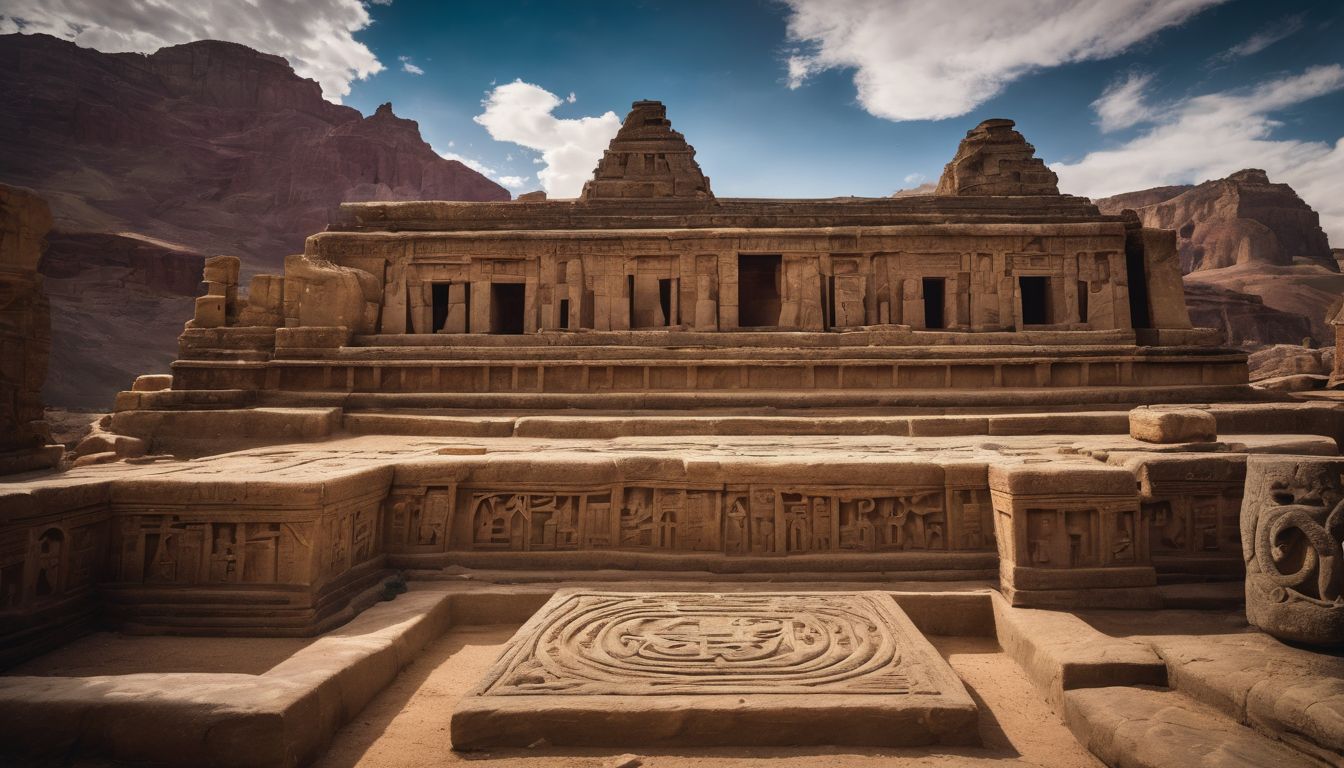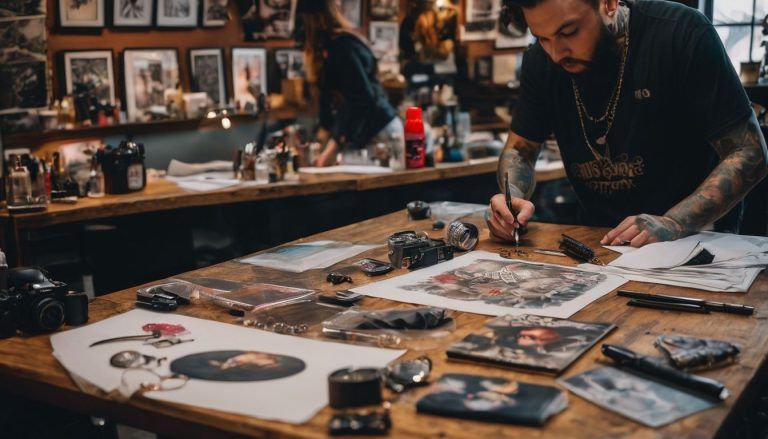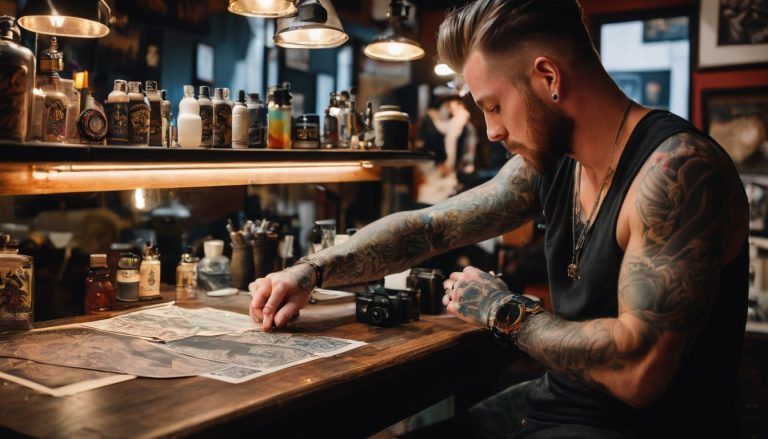The Meaning and History of Tattoos
Many people wonder about the stories behind colorful tattoos they see. Tattoos date back to at least Neolithic times, marking them as one of humanity’s oldest art forms. This blog dives into their rich history and meanings, helping to unravel the mystery inked on skin worldwide.
Get ready for a fascinating journey through time!
Key Takeaways
- Tattoos have been a significant form of self – expression and cultural tradition for thousands of years, with diverse meanings across different cultures and regions.
- Understanding the terminology, types (traumatic, cosmetic, medical), historical significance, process of getting a tattoo, cultural perceptions, safety concerns associated with tattoos is crucial for anyone considering getting inked.
- Religious views on tattoos vary widely across different faiths. Health risks associated with tattoos include infections while tattoo removal options include laser removal and surgical excision among others
- Popular culture has seen tattoos being used in advertising and marketing strategies as well as becoming prevalent in movies and music videos.
Understanding Tattoos
Understanding tattoos requires knowledge of the terminology, types (traumatic, cosmetic, medical), and their significance in different cultures. Whether it’s for personal expression or cultural tradition, tattoos have a rich history and meaning behind them.
Terminology
The term “tattoo” comes from the Samoan word “tatau,” which means to mark or strike, reflecting the traditional method of applying tattoos by tapping ink into the skin. Tattoos are permanent markings created by puncturing the skin and injecting tattoo ink, resulting in decorative body modifications.
These intricate designs can symbolize a wide range of concepts such as religious devotion, cultural significance, or personal milestones.
Different cultures have contributed various terms related to tattooing that describe specific styles or techniques. For example, “tribal tattoos” refer to patterns inspired by indigenous and ancestral clan motifs while “sleeve tattoos” describe ink that covers an arm like a shirt sleeve.
Every design speaks its own visual language; hence each style carries its distinct name within the rich tapestry of tattoo culture. Each term encapsulates centuries of evolution in tattoo symbolism and practices from across diverse societies around the globe.
Types (traumatic, cosmetic, medical)
Tattoos can result from various circumstances and needs. The three main types are traumatic, cosmetic, and medical.
- Traumatic tattoos occur when particles like dirt, asphalt, or gunpowder enter the skin during an accident.
- Cosmetic tattooing is used for enhancing features like eyebrows, lips, or as camouflage for scars.
- Medical tattoos are utilized to mark a specific area for radiation therapy or surgical procedures.
Historical Significance of Tattoos
Tattoos have been a part of various cultures around the world for centuries, with each region and society having its own unique traditions and meanings associated with tattoos. From Europe to North America, Australia to Latin America, and New Zealand, tattoos have played an important role in marking rites of passage, status, and spiritual significance.
Europe, North America, Australia, Latin America, New Zealand
The historical significance of tattoos varies across continents and cultures, reflecting a rich tapestry of beliefs and practices.
| Region | Historical Significance |
|---|---|
| Europe | Tattooing in Europe can be traced back to the Upper Paleolithic period. Practices varied greatly, from symbols of faith to marks of outcasts. |
| North America | Indigenous peoples used tattoos to signify tribal identity and achievements. European settlers later adopted tattoos for different purposes. |
| Australia | Aboriginal Australians practiced tattooing for cultural rites and as a form of social status within their communities. |
| Latin America | Ancient civilizations like the Maya and Aztec used tattoos for ritualistic purposes and to signify one’s place in society. |
| New Zealand | The Māori developed a unique form of tattooing called ‘ta moko’ which was integral to their culture, denoting lineage and status. |
This regional history underscores tattooing’s deep roots and diverse meanings within human society.
The Process of Getting a Tattoo
Tattoo artists use specialized equipment to puncture the skin and insert ink, following regulations to minimize health risks and associations with historical and modern tattooing practices.
Interested in learning more about the art of getting a tattoo? Keep on reading!
Equipment used
Tattooing equipment includes a tattoo machine which is powered by an electric motor, making needles move in and out of the skin at a frequency of 50 to 3,000 times per minute. The accessories and tools used during the tattooing process include:
- Needles: Used for injecting ink into the skin, they come in various configurations for different shading and lining techniques.
- Inks: Pigments are mixed with carrier solutions to create colorful tattoo inks, providing a wide range of hues.
- Power Supply: Provides the necessary electrical power to the tattoo machine, often adjustable to control needle speed.
- Grips: The handle where artists hold the tattoo machine; available in different sizes and materials for comfort and precision.
- Gloves: Essential for maintaining sterility during the entire tattooing process to prevent contamination and infection.
- Stencil paper and transfer solution: Used to transfer designs onto the skin before tattooing begins, ensuring accuracy.
- Medical supplies: Including antiseptic solutions, bandages, and disposable razors for cleaning and preparing the skin pre-tattooing.
- Furniture: Comfortable seating or tables are necessary for both clients and artists during longer sessions.
- Sterilization equipment: Autoclaves, ultrasonic cleaners, and disinfectants ensure all reusable equipment is free from pathogens between uses.
Regulations and health risks
Tattooing is regulated by local, state, and national authorities. The process poses health risks and needs careful consideration.
- Regulations vary between states and countries.
- Proper sterilization of equipment is crucial to prevent infections.
- Allergic reactions may occur due to tattoo ink ingredients.
- Inadequate aftercare can lead to skin infections.
- Bloodborne diseases can be transmitted if proper precautions are not followed.
- The FDA does not regulate tattoo pigments or inks.
- Removal of tattoos carries its own set of health risks.
Associations (historical and modern)
Throughout history, tattoos have been associated with various groups and movements. In ancient times, tattoos were often linked to tribal rituals and rites of passage. They were symbols of belonging and identity within the community.
For example, in Polynesian cultures, intricate tattoo designs denoted social status and served as a mark of honor. In modern times, tattoos are closely linked with subcultures such as bikers, punks, and rock musicians.
These groups use tattoos to express their allegiance to their respective communities and to convey specific messages or beliefs.
Moreover, contemporary society has seen an increasing acceptance of tattoos in professional settings. Many individuals now choose body art as a means of self-expression or commemoration rather than rebellion or defiance against societal norms.
Cultural Perceptions and Safety Concerns
Religious views on tattoos vary widely, with some cultures viewing them as taboo and others embracing them as a form of personal expression. Health risks associated with tattoos include infections, allergic reactions, and potential difficulties in removal.
Religious views
Religious views on tattoos vary widely across different faiths. In some cultures, tattoos are considered sacred symbols of spiritual significance and devotion. For example, in Hinduism, certain symbols or mantras may be tattooed onto the body to inspire protection and bring spiritual blessings.
Similarly, Polynesian cultures see tattoos as a representation of one’s connection to their ancestors and a means of expressing their religious beliefs through intricate designs that hold deep cultural meanings.
In contrast, many traditional interpretations within Christianity have discouraged the practice of tattooing due to verses in the Bible such as Leviticus 19:28 which warn against marking one’s body.
However, modern Christian attitudes towards tattoos have become more accepting with many individuals choosing to ink religious symbols or biblical verses as expressions of their faith.
Health risks and removal options
After considering religious views on tattoos, it’s important to understand the potential health risks associated with tattooing and the available removal options. Here are some significant facts to consider:
- Tattooing can pose risks such as skin infections, allergic reactions, and even bloodborne diseases like hepatitis B and C.
- Furthermore, the process of tattoo removal can be challenging and may lead to scarring or incomplete pigment removal.
- Laser removal is a popular method that involves breaking down the ink particles using high – intensity light beams. However, multiple sessions are often required for complete removal.
- Another option is surgical excision, where the tattooed skin is cut out and the remaining skin is stitched back together.
- Additionally, dermabrasion involves scraping off the outer layers of skin containing the tattoo ink, which may result in temporary redness and swelling.
- Finally, there are various topical creams that claim to fade tattoos over time but their effectiveness varies.
- It’s crucial for individuals considering a tattoo to educate themselves about potential health risks and carefully weigh their decision before getting inked.
Popular Culture and Tattoos
Tattoos have become a prominent feature in popular culture, often used for advertising and marketing purposes. They are also frequently seen in movies, music videos, and other forms of entertainment.
Religious significance and symbolism have also contributed to the popularity of tattoos in modern culture.
Advertising and marketing
Tattoos play a significant role in advertising and marketing, with many businesses using tattoo inspiration to create symbolic designs that resonate with their target audience. Advertisers leverage the cultural significance and spiritual symbolism of tattoos to connect with consumers on a deeper level, often utilizing inked skin as a means of promoting products or services.
Additionally, tattooing traditions are frequently incorporated into branding strategies to convey authenticity and establish meaningful connections with customers.
In popular culture, tattoos have become prevalent in advertising campaigns, serving as a visual representation of individuality and self-expression. As such, they are utilized to enhance brand image and appeal to diverse consumer demographics.
In popular culture
Tattoos have become increasingly prevalent in popular culture, with celebrities and influencers showcasing their intricate designs on various social media platforms. The representation of tattoos in movies, television shows, and music has also contributed to the normalization of body art.
Brands often collaborate with tattoo artists to create limited-edition clothing lines and accessories, further integrating tattoos into mainstream fashion. Additionally, tattoo conventions and expos have gained popularity as a way for enthusiasts to celebrate this form of self-expression.
– Religious significance and symbolism
Religious significance and symbolism
Tattoos hold significant religious meaning and symbolism in various cultures worldwide. They are often used to symbolize devotion, faith, and spiritual beliefs. For example, tattoos in Hinduism may depict deities or sacred symbols related to the divine.
In Christianity, individuals may choose to get tattoos of crosses, angels, or biblical verses as expressions of their faith. Similarly, in Buddhism and other belief systems, tattoos can represent enlightenment, protection from evil forces and spiritual guidance.
These designs not only serve as visual reminders of a person’s commitment to their religion but also reflect their cultural heritage.
In many ancient societies around the world like Egypt and Japan, tattoos were linked with religious practices such as rituals for passage into the afterlife or signifying adherence to specific deities.
Conclusion
In conclusion, the practice of tattooing has a rich and diverse history across various cultures. People have used tattoos as a way to express identity and status for thousands of years.
The meaning and significance of tattoos continue to evolve, shaping cultural perceptions and artistic expressions. Tattoos hold deep historical roots that have influenced modern society’s view on skin decorations.
The evolution of tattooing reflects the ever-changing human experience and remains an enduring form of self-expression worldwide.
FAQs
1. What are tattoos?
Tattoos are designs on the skin made by puncturing the surface and inserting ink to create patterns or images.
2. Why do people get tattoos?
People might get tattoos for many reasons, including as a way of expressing themselves, showing markings of status or significance, or because they enjoy the art form.
3. How did tattoos start?
The origins of tattooing go back thousands of years with ancient people using them as skin decorations and symbols that had cultural meanings.
4. Has the importance of tattoos changed over time?
Yes, through tattoo evolution, what started mainly as tribal markings can now widely vary in importance from artistic expression to personal memories.










